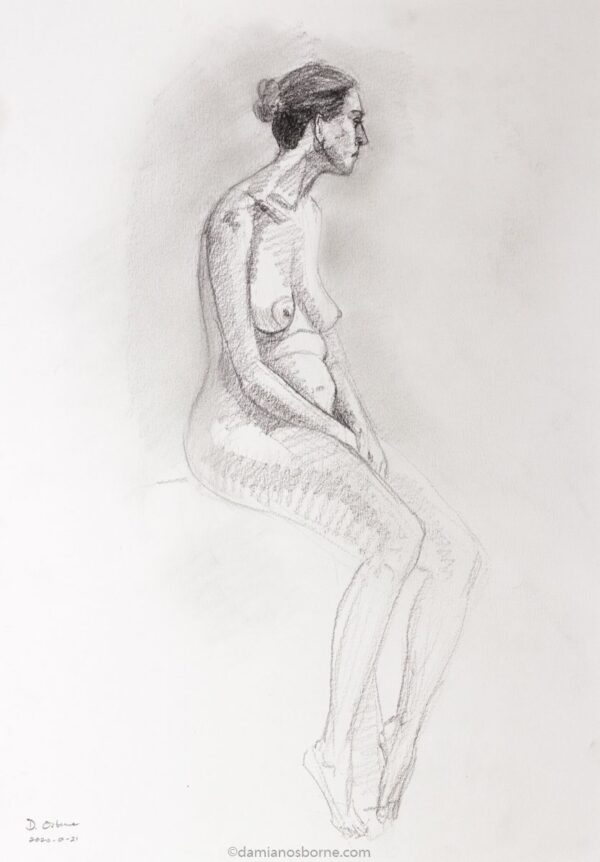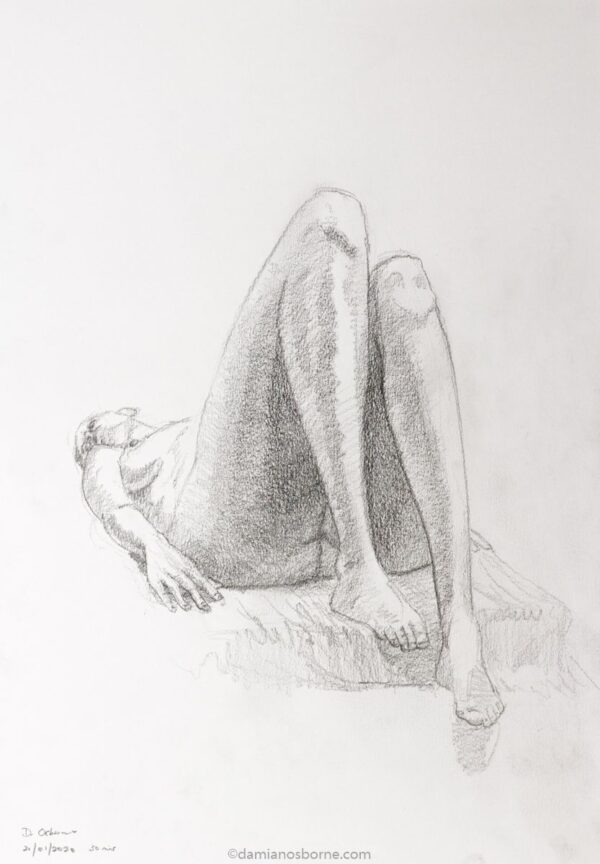Figure Drawing
Every Tuesday morning, I attend a figure drawing group. And oh, what a grumpy artist I can be if I skip a week. (My wife sure knows!)
This is the place where I get to just sit and draw. No distractions, no emails, phone calls, social media, talking — in fact, hardly any thinking.
Click on an image to view.
Mindfulness in figure drawing
When I’m drawing, my brain goes into a deep meditative auto-pilot.
My fingers are getting sooty from charcoal; I’m aware of the minute changes in pressure and angle of my pencil lead; watercolour or ink washes are doing their thing and I watch with fascination.
I’m studying the fibers, bones, shadows, shapes, rhythms, planes, creases, curves, masses and gravity of the human body.
Figure drawing is fundamental for an artist’s training. For learning to see, to understand, to practice, to be patient with oneself, to revere our humanness and our lives.
Some days, I’m not getting it. I have too much on my mind. My paper sucks, or my charcoal is scratchy. I can’t focus. My hand feels alien.
Other days, I’m in the magic space. Where everything is just coming together and it feels like someone else is almost drawing through me.
And yet, I know it’s me because I have such perfect control of my hand. My eye is seeing and balancing instantaneously. My materials are a dream to work with.
But most of the time, it’s kind of in between these two modes. Most of the year, I don’t really notice much in terms of improvement.
There are occasional ‘aha!’ moments (and every session I really do learn something — particularly about anatomy or how to interpret something).
But, I see the greatest difference when I start comparing my drawings from the year before.
It’s a very long journey, learning to draw. But I love it, and it’s amazing to know there’ll never be an end to training.
Drawing is being fully in the moment. And you never really see something until you try to draw it. And humans are the most fascinating things of all.
Why is a life drawing group so important?
As an artist, being stuck alone in the studio can be rather lonely. Therefore, having artist friends is important.
There’s a beneficial social aspect to joining a figure drawing group and seeing your friends every week, comparing drawings, chatting, and learning from each other.
In our figure drawing group, I acceded the responsibility of becoming the model-hirer. My other duties — which somehow have fallen upon my shoulders — is that of D.J. (I try to play nice classical music as much as possible), the time-keeper, and also, I’m sometimes called the Blind Man. Because I put down and raise the blinds.
I’m currently one of the younger folks in the group. So I don’t mind running up the stairs to sort out the blinds.
Attending a figure drawing class every week is a discipline. Sometimes, I get lazy and don’t want to go. But my wife makes me go, because she recognizes how important it is for my art, and for my general mood throughout the week.
Drawing the human figure from life on a weekly basis is probably the most beneficial thing I could do to improve the quality of my art. Particularly my figure paintings of course.
It improves my skills, my mood and even my brain. And it improves my understanding of anatomy. I try to look for all the things I learn from books and tutorials, now ‘in the flesh’.
Anyhoo, I’ve been making a YouTube playlist of my favourite classical music to play while painting or drawing. So if you like that sort of thing, check out Painting Music.
Life lessons in life drawings
I’ve taken my life drawing sessions a little more seriously this year. Probably because of the extra responsibilities. But, I think I’ve also started learning to let go a little more too.
I’m more serious in that I now attend every class (I kinda have to, because I must also pay the models). And I am really trying to improve my familiarity with anatomy, hone my tonal quality, not overwork my drawings so much, and get the gesture and grace in my lines.
I’m letting go more because, you know, you can’t force a drawing to be perfect. I’m learning to let my drawings go free a little more. Becoming a little less possessive over them. I am letting them show me what they are wanting to say, not what I think they should say.
I guess I’m maturing. Yes, I’ve always taken my work very seriously. But I’m learning to take myself more seriously so that people don’t waste my time or walk over me. Learning to put up boundaries.
At the same time I’m trying to letting the world show me more too, and I don’t think I need to have the last word always. I think that’s because I’m increasing in confidence generally. In myself, and in my art.
Figure drawing study and practice
I think there is study, and then there is practice. Study would be things like drawing diagrams of anatomy, copying master works, going onto YouTube or reading a book or a blog on drawing tips, the structure of the human body etc.
Study usual equals fairly quick results because it’s relatively easy to learn something. Keeping it in your long term memory is another issue.
Practice is all the other time spent, with pencil or charcoal in hand, honing your craft. Practice usually means rather slow results. Like years and decades.
Learning to see, I think falls under practice. It takes a lot of practice to see and to retain information. To see more objectively and measure quickly and intuitively. Getting a feel for your paper, finding the perfect way to hold your pencil, micro-balancing your arm in mid-air while shading, making lines that flow, getting a likeness, and creating a believable sense of weight, volume and light, also fall under practice.
Drawing is a language. Beyond all the practicing, is an elusive realm even more difficult to reach. The arena of emotions and pure expressiveness.
I always think of life drawing practice in the same way that a violinist practices their bowing technique, their sight-reading, their senses, and making music that flows and is flawless; music that has colour, expresses emotions and transports us from the ordinary.
Life drawing from a nude model is both study and practice. I look for the things that I studied at home earlier, now in the model standing before me.
And I then go into a deep meditative space, listen to the music, and let the drawing tell me what to do.
Check out some more life drawings here:
Available Figure Drawing Archive
Click on an image to view.
-

Life Drawing 2020-01-14 no.5
$30.00 Add to basket -

Life Drawing 2020-01-14 no.6
$30.00 Add to basket -

Life Drawing 2020-01-14 no.7
$30.00 Add to basket -

Life Drawing 2020-01-21 no.3
$30.00 Add to basket -

Life Drawing 2020-01-21 no.4
$30.00 Add to basket -

Life Drawing 2020-01-21 no.5
$30.00 Add to basket -

Life Drawing 2020-01-28 no.6
$30.00 Add to basket
Check out some of my figure paintings. To read more about The Sirens series, click here.








